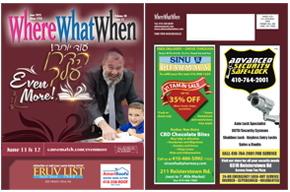Everyone who has children worries about chinuch (education). From the time a baby is born – and does nothing but sleep, eat, and cry – parents worry: Will the baby become spoiled if I pick him up the minute he cries? If I let her cry, am I teaching her that I don’t care? As the child grows older, the dilemmas just multiply, and of course, when he or she goes to school, chinuch becomes the teacher’s problem, too.
Are the children of our generation
different from children 50 years ago? Probably. Each generation of children is
affected by the surrounding society – as are parents and teachers. While we
like to imagine that they used to just “know” how raise and educate children,
whereas we have lost our way, maybe we are idealizing the past, and our
confusion stems from today’s different social realities. Or maybe we are merely
more aware of the complexity of the task. To get some insight on this very
important topic, I surveyed parents, teachers, administrators, authors, and
parenting instructors.
Today’s
Children
Sima, a retired teacher, said, “I
taught for 25 years, but I couldn’t teach now. The children today don’t have
the respect for adults that we used to have. For example, when I was a child,
all adults were addressed as Mr. or Mrs. or Tanta. Today, the children on my
block call me by my first name! My mother’s favorite expression was ‘I am your
mother, not your friend.’ Today, children and adults act more like friends, and
there are fewer boundaries in place.”
Tova,
another teacher, remarked, “Things that I have been using for prizes for many
years do not work anymore because they are not so special for the children.
Children have more stuff! A child showed me that she had gotten a present from
a relative. The present was the same item that I had been using for a reward in
class. Of course, that took away the motivation from that student to earn the
prize.”
Mrs. Rivka Levitansky, of Positive
Parenting, agrees that children are indeed different today. She says, “In
today’s culture, people are afraid to say no to their children. Although we
want our children to be happy, saying no when necessary is not a contradiction
to happiness. In fact, children who grow up with limits and boundaries are happier and more successful because they’re more prepared to deal
with life’s inevitable frustrations and challenges.
“Parents should be confident when
they decide to say no to their child,” says Mrs. Levitansky. “No parent would
hesitate to say no to their child about playing in the street. In the same way,
be confident that what you have decided is correct and stay firm. Lessons
learned at a young age are the ones that become most deeply ingrained.”
At the same time, Mrs. Levitansky clarifies that the limits, boundaries, instructions, and punishments should
only be a small part of the day. Positivity has to comprise the vastly greater
percentage of their interactions. “In earlier years, there certainly was
much more negativity, but kids weren’t as fragile as they are today. Today,
kids still need limits, but they should be fewer and more thought out.”
I asked my grandson, who has been a
yeshiva student for many years, if he thinks bachurim are less respectful than they were 20 years ago. He
thought they were: “I think boys are much faster to ask not-so-smart questions
without thinking, whereas in the past, students were more careful only to say
things that were well thought out.” He adds that each yeshiva has a different
culture. Some encourage familiarity between the staff and the students, and
some demand more respect. For example, he says, one sign of respect that is
less common now is putting on a hat and jacket before speaking to a rebbi.
Rivky, another teacher, says, “I’ve
noticed that today, it is almost as if an event didn’t happen unless you have a
picture to prove it. This carries over to the classroom and affects the way the
subjects are taught. Children are exposed to visual media at a very young age,
and that makes it harder for them to pay attention to things that do not have
pictures and movement. Children have much shorter attention spans unless I use
visual aids.”
And of course, there is a big
difference in the numbers of students. When I was in Bais Yaakov, we had one
class in each grade with about 17 or 18 students. Today, an average grade can
have more than 100 students. This influences how trips and events are planned
and how much interaction there is between the students and teachers. More
planning, more buses, more staff, and less individual attention for each
student.
But we don’t get to choose when we
are born, and parents must deal with their children when they arrive. One idea
to remember is that things are not always as they appear. Parenting and
teaching children have always been challenging, although the challenges may be
different than they were 50 years ago, and we still can benefit from advice. Here
are some ideas from educators on how to achieve success.
Honesty
I like listening to a podcast
called “Meaningful People,” where the host, Nachie Gordon, dialogues with interesting
people. Recently, he interviewed Rabbi Daniel Kalish, who runs a yeshiva in
Waterbury, Connecticut. This yeshiva is known to work with boys who are
struggling with Judaism, and the philosophy of the yeshiva seems to be based on
loving every boy and being very lenient about rules. Some people criticize the
yeshiva for their approach.
Rabbi Kalish said that this criticism of the
yeshiva is not correct. “To some people, a good teacher is someone who can
manipulate children to behave the way he wants them to. This is not the mark of
a truly great mechanech (educator).
Rather, Rabbi Kalish says that the sign of a great mechanech is honesty. “It is very difficult to
be honest, and it is doubly as difficult to be honest in front of a class full
of children. That is true education: being sincere, authentic, and real. A
Torah teacher must share Torah from an honest space. The philosophy of my
yeshiva is not just to dispense love but to share oneself honestly.”
Setting
an Example
I came across a book called Spare the Child: Essentials of Torah Chinuch
by Rabbi Yechiel Yaakovson, which addresses this same topic of perception
and honesty: “Parents and teachers may think that the best way to educate a
child is to set a good example,” he writes. “That is true, but the example is
not always what the adult thinks he is portraying but what the child absorbs…according to his understanding and
perception. This can be very different from the way the adult may view or
relate to it. Only the true, natural behavior of the adult will effectively
serve as a personal example, since it is only those behaviors that the child
will tend to imitate.”
The
author mentions a story many of us have heard that is a good example of this
concept. In the early part of the century, it was very difficult for people to
keep Shabbos because the work week included Saturday. Some people were fired
every week because they refused to work on Shabbos. Although these people
sacrificed a great deal to keep Shabbos, they often complained and talked about
how Shabbos was a big burden to them. Yes, the parents set a great example
about the importance of Shabbos, yet their children did not always remain shomer Shabbos. The children did not learn
the supreme value of Shabbos; instead, they learned that Shabbos was a burden.
Rabbi Yaakovson tells another story
that illustrates this concept: Once, a school did not like that their students
were very busy playing with marbles. The school’s administration had a meeting
and decided to forbid the boys from playing with marbles. One teacher was very
upset. He said, “What kind of chinuch
approach have you developed? An approach of solving problems by covering them
up? If you tell them not to play with marbles, do you think they’ll listen? If
they really want to play – and perhaps even need to play – all you’re doing is
adding another dimension to the game: sneakiness. The kids will have to learn
how to trick you and play behind your backs.” The school did not intend
to teach sneakiness, but that is what the children learned.
Another concept Rabbi Yaakovson
addresses is how materialism influences chinuch. Many children have
collections of things. I would have thought that collections are harmless. But
Rabbi Yaakovson looks deeper into this phenomenon:
By
children’s collections, we refer to things that are mainly amassed for the sake
of the collection. In other words, things that the child does not collect in
order to use or play with, but simply in order to have as many as possible….
These collections involve an issue of possessiveness… The child’s pleasure lies
in the very fact that he owns so many of them. Even when the child is busy with
the collection, he is not enjoying the items but rather relishing the extent of
his assets.
Whose
Problem Is It?
In a quest to help parents deal
with today’s children, Mrs. Mindi Hauer of Baltimore offers a class called One Chart
Parenting. About 10 years ago, frustrated that there seemed to be no single “catch-all” program that
addressed all parenting issues, she met “the wisest and most sought-after
parenting educator, Rebbetzin Leah Trenk.” Rebbetzin Trenk introduced her to “an
all-encompassing, brilliantly organized, and supremely effective parenting
approach, which is appropriate for all ages and stages, not to mention all
relationships.”
While obviously impossible to
convey all the details of this program, its essence seems to be to first clarify
whose problem it is: Is it the parents’ problem, the child’s problem, or the
parents’ and the child’s problem? Instead of parents having to recall the parenting instructor’s
approach to each area of behavior – that is, how to handle sibling rivalry,
what to do when a child has a conflict with a teacher, or how to respond to
chutzpa – with One Chart, a parent need ask only one question: What category of
problem is this? Based on the answer, the parent then proceeds with the
appropriate tool for that category. For example, if it is the child’s
problem – the child scraped his knee, is having a social challenge, or is unprepared
for a test – the correct response would be active listening. “This is a form of
listening in which the listener focuses very intently on what the speaker is
sharing, reflecting back the feeling the speaker is communicating,” says Mrs.
Hauer.
Another key element of the program
is to capitalize on those occasions when there is no problem. This is done by both praising children for what they
are doing well and carving out time to spend with each of them individually. “These
deceptively simple strategies are indescribably impactful in enriching
parent-child relationships as well as encouraging children to want to do their
best,” concludes Mrs. Hauer. Indeed, these simple strategies are appropriate
not only between parents and children but all relationships, including being a
game changer for shalom bayis.
*
* *
Educating children in 2025 is challenging. Luckily for us there is a lot
of advice and information out there to help us navigate this confusing world.
sidebar
Mindi Hauer offers 10 live 1.5-hour
Zoom sessions, 8:30 p.m. once a week. Weekly recordings are available. To
learn more, email info@onechartparenting.com or listen to the DMC podcast
entitled “One Chart Parenting with Mrs. Mindi Hauer.”
Rivka Levitansky
has been giving chinuch bonim (parenting)
classes for over 20 years and also does private sessions as a parenting coach. See
her website at positiveparentinglive.com.
Meaningful People podcast: “An Interview
with Rabbi Daniel Kalish, Acclaimed Educator: I Can’t Hold This Inside Anymore”
Spare
the Child: Essentials of Torah Chinuch by Rabbi Yechiel Yaakovson, Machon Yedidyah
(translated from Hebrew), 2019






